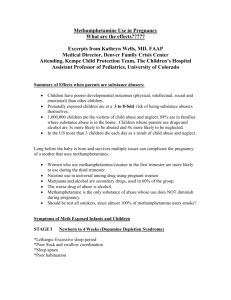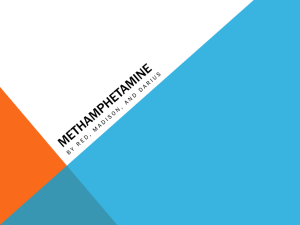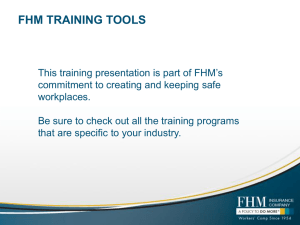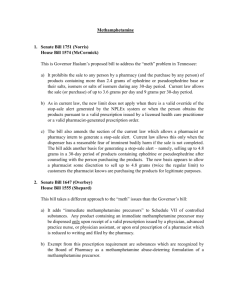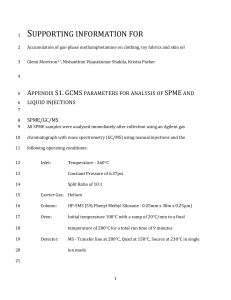“International Meth Trafficking” Senate Foreign Relations Committee
advertisement
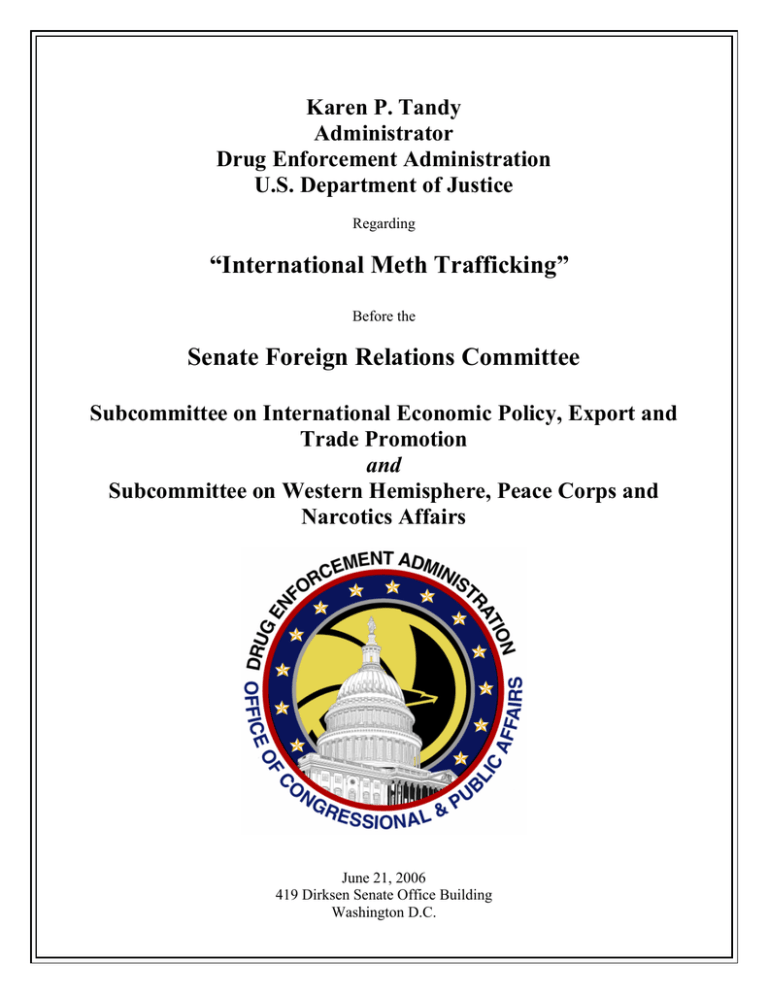
Karen P. Tandy Administrator Drug Enforcement Administration U.S. Department of Justice Regarding “International Meth Trafficking” Before the Senate Foreign Relations Committee Subcommittee on International Economic Policy, Export and Trade Promotion and Subcommittee on Western Hemisphere, Peace Corps and Narcotics Affairs June 21, 2006 419 Dirksen Senate Office Building Washington D.C. Introduction Chairman Hagel, Chairman Coleman, Senator Sarbanes, Senator Dodd, and distinguished members of the Senate Foreign Relations Committee, on behalf of the Drug Enforcement Administration (DEA), I appreciate your invitation to testify today regarding DEA’s efforts to combat the international trafficking of methamphetamine. Overview Methamphetamine poses a unique and significant threat to the United States. Methamphetamine is unique in that it is a synthetic drug, it is not dependent on cultivation of a crop, its production requires no specialized skill or training, and its precursor chemicals have historically been easy to obtain and inexpensive to purchase. These factors have contributed to methamphetamine’s rapid sweep across our nation. This drug is a threat because it is powerfully addictive to those who use it, and because it can cause harm even to those who are not involved in its use or distribution. Those who suffer the “second hand” effects of methamphetamine include the victims of methamphetamine-related crimes, innocent children whose homes have been turned into clandestine lab sites, law enforcement officers that work with the hazardous materials found at lab sites, and the environment from the five to six pounds of toxic waste produced for every pound of methamphetamine cooked. Methamphetamine has not only left a mark on the United States, but continues to be a significant problem in Asia and is increasingly becoming a problem in other parts of the world. Methamphetamine also presents a dual threat to law enforcement authorities. They must simultaneously combat both small toxic labs (STLs), which have spread across much of our nation and “super labs,” which are primarily controlled by Mexican drug trafficking organizations and are supplying the majority of the methamphetamine consumed in this country. The critical tool in combating both of these types of labs is the control of methamphetamine’s primary precursor chemicals: ephedrine, pseudoephedrine, and phenylpropanolamine1. In response to the threat posed by methamphetamine, the DEA continues to aggressively combat this drug through our domestic and international enforcement efforts. Domestically, law enforcement efforts have been aided by State and Federal legislation placing restrictions on the sale of methamphetamine’s precursor chemicals. Of note, the recent passage of the re-authorization of the USA PATRIOT Act (particularly Title VII, the “Combat Methamphetamine Epidemic Act of 2005”) has provided important additional tools to enhance law enforcement efforts both domestically and internationally. The DEA, through our law enforcement partnerships across the country and around the world, has initiated successful investigations that have disrupted and dismantled significant methamphetamine trafficking organizations. We also have taken an active role in fighting the diversion of methamphetamine’s key ingredients, ephedrine and pseudoephedrine. These efforts, through both enforcement and international agreements, have resulted in a substantial reduction in the amount of precursor chemicals entering the United States. However, with this success, we have seen an increase in the flow of these precursor chemicals to Mexico, and an increase in the trafficking of finished meth across the Southwest border into the United States. 1 Phenylpropanolamine is a precursor chemical for amphetamine, rather than methamphetamine, although the production process is essentially identical. 1 In addition, the Department of Justice, with the help of federal, State, and local law enforcement, has been committed to prosecuting methamphetamine traffickers. Over the past five years, data shows there has been an increase in the number of methamphetamine defendants charged by U.S. Attorneys’ offices and sentenced by U.S. District Courts. U.S. Attorney case data shows a 34 percent increase2 in the number of defendants charged over the past five years. Data from the Sentencing Commission also shows a similar significant increase, finding a 42 percent increase3 in the number of defendants sentenced over the past five years. Methamphetamine – Threat Assessment Methamphetamine consumed in the United States originates from two general sources, controlled by two distinct groups. Most of the methamphetamine consumed in the United States is produced by Mexico-based and California-based Mexican traffickers. These drug trafficking organizations control “super labs” (a laboratory capable of producing 10 pounds or more of methamphetamine within a single production cycle), and have distribution networks throughout the United States, as well as access to drug transportation routes to smuggle the methamphetamine from Mexico into the United States. Current drug lab seizure data suggests that roughly 80 percent of the methamphetamine used in the United States comes from these larger labs, which are increasingly found in Mexico. These same Mexican criminal organizations control most mid-level and retail methamphetamine distribution in the Pacific, Southwest, and west-central regions of the United States, as well as much of the distribution in the Great Lakes and Southeast regions. The second source for methamphetamine used in this country comes from small toxic labs (STLs). These STLs produce relatively small amounts of methamphetamine and are generally not affiliated with major trafficking organizations. Currently, DEA estimates that STLs are responsible for approximately 20 percent of the methamphetamine consumed in this country. Initially found only in most Western States, over the past 10 years there has been an eastward expansion of STLs across the United States. A number of factors have served as catalysts for the spread, including the presence of “recipes” easily accessible over the Internet, ingredients needed to produce methamphetamine which were available in many over-the-counter cold medications and common household products found at retail stores, coupled with the relatively simple process involved to manufacture methamphetamine. Today, thanks in large part to the legislative restrictions placed on the sales of methamphetamine precursor chemicals, the DEA expects to see a significant decrease in the number of STLs found this year. The manufacture and use of methamphetamine is not a problem confined to the United States, but one that has spread to many regions of the world. In fact, the International Narcotics Control Board (INCB) noted in its 2005 report “Precursors and Chemicals Frequently Used in the Illicit Manufacture of Narcotic Drugs and Psychotropic Substances,” that the illicit manufacture of methamphetamine is spreading throughout the world at an alarming rate. Globally, the number of users of amphetamine-type stimulants – a majority of which use methamphetamine - outnumber cocaine and heroin users combined. 2 There were 5,120 defendants charged in FY 2005, compared to 3,815 defendants charged in FY 2001. There were 4,839 defendants sentenced in FY 2005 (including both Pre-Booker and Post-Booker cases), compared to 3,414 defendants sentenced in FY 2001. 3 2 Specifically, the INCB indicated that the illicit manufacture of amphetamine-type stimulants (ATS)4, and of methamphetamine in particular, is spreading in North America and South-East Asia, but also increasingly to other areas such as Africa, Eastern Europe, and Oceania. There are an estimated 26.2 million ATS users in the world, compared to an estimated 13.7 million cocaine users and 10.6 heroin users. The report further stated that the spread of methamphetamine is due to the simple manufacturing process and the availability of the required precursors. The DEA’s Enforcement Efforts The DEA believes that international cooperation is the key in combating methamphetamine. Some of the most significant and successful international efforts to combat methamphetamine involve a series of enforcement initiatives worked jointly between law enforcement in the United States and Canada from the late 1990s into 2003. These enforcement initiatives, known as Operations MOUNTAIN EXPRESS I, II and III and Operation NORTHERN STAR, were principally responsible for the significant reduction in the amount of pseudoephedrine entering the United States for use in Mexican-controlled super labs. In turn, most of the super labs and the pseudoephedrine needed for them moved from the United States to Mexico. DEA’s longstanding enforcement efforts against methamphetamine include utilizing the Consolidated Priority Organization Targets (CPOTs) List, the Priority Target Organization (PTO) program, and the Organized Crime Drug Enforcement Task Force (OCDETF) program. The programs all provide assistance in identifying and targeting the most significant methamphetamine trafficking organizations, with the intent to disrupt and dismantle the organizations. The FY 2006 CPOT list has identified 8 of the 46 designated organizations as being engaged in methamphetamine trafficking, 7 of these 8 are Mexican CPOT targets. At the end of the second quarter of FY 2006, the DEA had 149 active PTO investigations linked to those 7 CPOTs, of which 28 were active PTO investigations with methamphetamine as the primary type of drug. Since the inception of the PTO program in 2001, the DEA has either disrupted or dismantled more than 460 PTOs, where methamphetamine was the primary drug involved. To enhance our international efforts to combat this drug, DEA has assigned Diversion Investigators (DIs) to a number of our foreign offices. These DIs, through their knowledge of pharmaceuticals and chemicals, play a critical role in preventing the diversion of List I chemicals which are used in the manufacture of methamphetamine and of pharmaceutical controlled substances. The DIs coordinate with foreign host country counterparts to establish effective systems of chemical controls and to ensure that customers in foreign countries receiving U.S. exports of pharmaceutically controlled substances are in fact legitimate companies. Foreign-based Diversion Investigators were intricately involved in two DEA operations in Hong Kong and Mexico run under the auspices of Project Prism that resulted in significant seizures of pseudoephedrine. In addition to these DEA-specific activities, the DEA works internationally though a variety of existing international efforts. Project Prism is an international initiative aimed at assisting governments in developing and implementing operating procedures to control and more effectively monitor trade in ATS precursors to prevent their diversion. There are currently 95 countries and 5 international organizations participating in this initiative. Since March 2004, Project Prism has used pre-export 4 In Europe and Asia the term “amphetamine-type stimulants” is used rather than a specific reference to methamphetamine. The term ATS includes the following: amphetamine, methamphetamine, and MDMA (Ecstasy), and its analogues. This term is also used by the United Nations 3 notifications to monitor shipments of ephedrine, pseudoephedrine, pharmaceutical preparations containing ephedrine or pseudoephedrine, phenyl-2-propanone, and 3,4-methylenedioxyphenyl-2propanone. Under Project Prism (through the end of 2005), over 5 metric tons of 60 milligram tablets of pseudoephedrine were seized in the United States, Mexico, and Panama. These pseudoephedrine tablets could have produced over 3 metric tons of methamphetamine (at a 60 percent conversion rate). The FY 2006 Department of Justice Appropriations Act directs the Attorney General to establish a Methamphetamine Task Force (MTF) within DEA. The purpose of the Task Force is to improve and target the Federal government’s policies on production and trafficking of methamphetamine. The MTF is comprised of three DEA Special Agents, two Diversion Investigators, three attorneys, and one Program Analyst. These are veteran personnel with extensive experience and knowledge in the field who will collect and analyze investigative and intelligence information from numerous sources. Their analysis will focus on trends in chemical trafficking and manufacturing methods, changes in trafficking routes and patterns, and regional abuse and distribution patterns. While DEA continues to aggressively target the flow of foreign and domestic precursor sources and smuggling efforts, to include methods of financing, the MTF will review DEA enforcement efforts with an eye toward identifying new trends. In addition, the MTF will be involved in chemical and equipment sources, methods of procurement, and clandestine laboratory cleanup issues. Another aspect of the MTF’s duties will be making recommendations addressing issues that are identified from their analysis. These recommendations ultimately will be forwarded to the National Synthetic Drugs Interagency Working Group for review and action. The DEA also continues its work to ensure that only legitimate businesses with adequate chemical controls are licensed to handle bulk pseudoephedrine and ephedrine in the United States. In the past seven years, over 2,000 chemical registrants have been denied, surrendered, or withdrawn their registrations or applications as a result of DEA investigations. We investigated the adequacy of their security safeguards to prevent the diversion of chemicals to the illicit market, and audited their recordkeeping to ensure compliance with federal regulations. In addition to an initial on-site inspection, DEA Diversion Investigators, between 2001 and 2005, have physically re-inspected nearly seventy-five percent of the 3,000 chemical registrants at their place of business. The International Control of Precursor Chemicals With the increase in the diversion of precursor chemicals and the corresponding need for closer monitoring of chemical shipments, certain foreign governments in chemical source countries require a permit or written authorization from an importing country’s government stating the legitimacy of the transaction. Under Federal law, the DEA must be notified only if an ephedrine or pseudoephedrine product is destined for, or will transit through, the United States. But the legal and regulatory tools to limit imports and after-import distribution were relatively insufficient. Moreover, the prevailing interpretation of the 1988 United Nation's Convention that controls chemicals exempts most finished pharmaceutical products containing pseudoephedrine in combination with other ingredients by allowing them to be shipped in international commerce without pre-notification—a loophole that continues to be exploited by drug traffickers. These pharmaceutical preparations contain pseudoephedrine and are used in the manufacture of methamphetamine. Since modification of the 1988 UN Convention is unrealistic, the United States, along with a number of our counterparts, has been working to gain international support for voluntary international cooperation to pre-notify shipments of these products. These efforts are being pursued by the U.S. through the drug control commission of the Organization of American States ("CICAD"), through the UN Commission on Narcotic Drugs, and bilaterally with selected nations. 4 Until passage of the Combat Methamphetamine Epidemic Act of 2005, U.S. law did not involve a permit-based system. Any company that imported or exported ephedrine, pseudoephedrine or phenylpropanolamine was required to notify the DEA of the transaction. This was not a permit for the transaction but rather a declaration that the transaction would take place. In other countries, companies must obtain a permit before importing or exporting regulated chemicals. The 1988 U.N. Convention recommended that countries implement a permit system for chemical imports and exports, (Paragraph 8(b)(iii)), and some countries (e.g. Germany, China, and India) have implemented this system. Other countries consider chemicals such as pseudoephedrine to be pharmaceutical drugs and therefore issue permits for their import and export. The Combat Methamphetamine Epidemic Act makes it unlawful to import into the United States ephedrine, pseudoephedrine, and phenylpropanolamine except as DEA, by delegation, finds to be necessary to provide for medical, scientific, or other legitimate purposes. DEA is working to implement this system through the promulgation of regulations. This system, in conjunction with a system of quotas for ephedrine, pseudoephedrine, and phenylpropanolamine also established by the Combat Methamphetamine Epidemic Act of 2005, will provide greater control over the importation and distribution of these three chemicals. International Cooperation International cooperation is key in combating methamphetamine and its precursor chemicals.5 The DEA has had the lead for the United States in working with our Mexican counterparts to combat methamphetamine. This cooperative effort extends into several areas of support. Since 2001, the DEA has provided training to our Mexican counterparts regarding clandestine laboratories, chemical training, and prosecution. Training has been provided to officials who regulate precursor chemicals and pharmaceuticals at the state and federal level within Mexico, as well as agents from the Agencia Federal de Investigaciones (AFI) and a number of prosecutors within the Mexican Organized Crime Unit (SIEDO). Over 450 students have received training through this cooperative effort. In addition, the United States and Mexico have jointly obtained a commitment from Hong Kong not to ship chemicals to the United States, Mexico, or Panama until receiving an import permit or equivalent documentation and giving prior notification to the receiving country before shipment. If suspect shipments can be identified before they arrive in Mexico, it is easier for law enforcement to take effective action by either attempting to seize the shipment or by conducting a controlled delivery of the chemicals in order to identify the traffickers and the shipments ultimate destination. Mexico has independently implemented several important voluntary controls on pseudoephedrine in cooperation with the industry, and is considering others. Those implemented now, or planned soon, include (1) limiting retail sales to pharmacies; (2) limiting sales quantities to three boxes of approximately 9 grams total; and (3) distributors voluntarily agreeing to limit sales to 5 One of the most significant and successful international efforts to combat methamphetamine’s precursor chemicals involved a series of enforcement initiatives worked jointly between law enforcement in the United States and Canada from the late 1990s into 2003. These enforcement initiatives, known as Operations Mountain Express I, II and III and Operation Northern Star, were principally responsible for the significant reduction in the amount of pseudoephedrine entering the United States for use in Mexican controlled super labs. In turn, most of these super labs and the pseudoephedrine required for the labs to produce methamphetamine moved from the United States to Mexico. 5 customers with appropriate government registrations (pharmacies) and with legitimate commercial needs. Additionally, Mexico recently imposed a policy limiting imports of pseudoephedrine and ephedrine to manufacturers only, and limits importers to shipments of no more than 3 metric tons at a time. Wholesale distributors are barred from importing raw material pseudoephedrine and ephedrine. These importation restrictions have been coupled with recently imposed import quotas tied to estimates of national needs, which are based on extrapolations from a large population sample. Through a study, The Federal Commission for the Protection against Sanitary Risk (COFEPRIS) revealed that there is an excess of imports of pseudoephedrine products of approximately 60 to 100 metric tons. This study showed that the highest peak of respiratory diseases in Mexico was registered in 1999 with 29 million cases. That year, pseudoephedrine imports accounted for approximately 55,000 kilograms. In 2003, there was a slight decrease of reported respiratory diseases to approximately 27 million cases; however pseudoephedrine imports increased to 159,000 kilograms. Equally, in 2004 there were 28 million respiratory cases compared with 216,000 kilograms of pseudoephedrine imported. COFEPRIS determined that these imports were not related to the epidemiological index. The DEA has been advised that it is the Government of Mexico's intention to reduce pseudoephedrine and ephedrine importation permits to 70 tons, in 2006. These permits are to be split evenly among the Mexican-based pharmaceutical manufacturing companies. This is a significant reduction from the 2005 pseudoephedrine and ephedrine importation levels. Mexican officials have further advised that this 70 ton limit also applies to combination products containing pseudoephedrine and/or ephedrine. Mexico’s efforts to control methamphetamine precursor chemicals have not been limited to regulatory actions. An example of Mexico’s pseudoephedrine interdiction efforts occurred during December 2005, when approximately 3.2 metric tons (approx. 5.1 million pseudoephedrine combination tablets) of pseudoephedrine were seized by Mexican authorities in the Port of Manzanillo, Mexico. The tablets were concealed within a shipment of electric fans, which were packaged in approximately 1,260 boxes. During the follow-up joint investigation conducted by DEA and the Hong Kong Customs and Excise Department, officials disclosed that the shipment of electric fans containing the tablets originated in mainland China and transited one of the mainland China/Hong Kong border crossings before being loaded on a marine vessel en route to Mexico. In addition to these efforts with Mexico, the DEA, operating under the auspices of Project Prism, hosted a meeting in February in Hong Kong for law enforcement and regulatory officials from countries that produce ATS precursor chemicals. The purpose of this meeting was to develop and enhance systems for voluntary cooperation in data collection to build a consensus towards exchange of information on pharmaceutical preparations containing ephedrine and pseudoephedrine as well as bulk precursors. This was the first time that almost all of the countries that produce these chemicals and those countries affected by methamphetamine have sat down together to discuss this problem. While there were some differences of opinion as to the manner and channels in which information regarding the licit trade in these substances should be exchanged, the communication that occurred between countries attending the open forum meeting was encouraging. Although we were disappointed that China chose not to send a delegation, the DEA, in cooperation with the Department of State, will continue discussions with all involved countries to determine the worldwide production of these chemicals, identify producers and distributors, gain better insight as to what form (bulk versus. tablets) the chemicals are manufactured and distributed at various stages, and learn where the chemicals are destined. In fact, during the week of June 5, a contingent from China came to DEA headquarters and 6 met with high level officials in part, to discuss the many aspects involved in the importation of these precursor chemicals. The Hong Kong meeting also helped to lay a foundation for the discussions and negotiation among concerned governments which led to the passage of a resolution at the 49th Commission on Narcotic Drugs (CND) in Vienna, Austria, in March of this year. The resolution, entitled “Strengthening Systems for Control of Precursor Chemicals Used in the Manufacture of Synthetic Drugs,” involves the methamphetamine precursors previously mentioned, as well as preparations containing these substances, and phenyl-2-propanone (P2P) as well. The resolution, which was adopted by the CND on March 15, 2006, calls on UN member states to provide to the International Narcotics Control Board (INCB) annual estimates of their legitimate requirements for these substances, and preparations containing these substances, and to ensure that its imports of these substances are commensurate with their respective nation’s legitimate needs. It is anticipated that the legitimate requirements estimates provided to the INCB will be published in their annual precursor report, the next of which is scheduled to be released in March 2007. The resolution also urges countries to continue to provide to the INCB, subject to their national legislation and taking care not to impede legitimate international commerce, information on all shipments of these substances, to include pharmaceutical preparations. Finally, the resolution requests countries grant permission to the INCB to share the shipment information on these consignments with concerned law enforcement and regulatory authorities to prevent or interdict diverted shipments. At present, DEA, as a member of the Project Prism task force, is working with the task force to come up with an initial initiative to address some of our specific concerns regarding the flow of these important precursors to the Western hemisphere. While this resolution is an important first step, it will take several years to be fully implemented. Its success will depend upon our ability to obtain additional information from the INCB, which is contingent upon nations providing the information requested pursuant to the resolution. Recent Developments At the National Methamphetamine and Chemicals Initiative (NMCI) Strategy Conference in Dallas last month, Attorney General Gonzales announced important new anti-methamphetamine domestic initiatives as well as new partnerships between the U.S. and Mexico in fighting methamphetamine trafficking. Joined by Mexican Attorney General Daniel Cabeza De Vaca, Attorney General Gonzales unveiled several Department of Justice-led initiatives aimed at improved enforcement, increased law enforcement training, improved information-sharing, and increasing public awareness. Among the U.S./Mexico partnership efforts is an agreement between DEA and the Government of Mexico to establish specialized methamphetamine enforcement teams on both sides of the border. In Mexico, these teams will focus on investigating and targeting the most wanted Mexican methamphetamine drug trafficking organizations, while DEA-led efforts on the U.S. side will focus on the methamphetamine traffickers and organizations transporting and distributing the methamphetamine that was produced in Mexico. Other initiatives that are part of the U.S./Mexico partnership include: 7 • A new DEA and U. S. Customs and Border Protection Service effort to focus on ports of interest within the United States and target suspicious cargo that is likely to be related to methamphetamine trafficking organizations; • A bi-national Law Enforcement Working Group that will focus on methamphetamine production and trafficking from both an enforcement and intelligence perspective; • A DEA and Mexican CENAPI effort to further share intelligence information and continue to develop stronger working relationships. Such collaborative efforts will focus on investigating large-scale meth trafficking organizations that are operating in Mexico and the United States. • A “Most Wanted Methamphetamine and Chemical Drug Trafficking Organization List” jointly developed by DEA and Mexican police. The list will focus bilateral law enforcement efforts on the most significant threats; • An agreement between the DEA Office of Diversion Control and Mexico’s chemical regulatory agency, COFEPRIS, to a personnel exchange in which chemical regulatory experts from within each agency will be embedded within the other’s agency for a specific period to observe, learn best practices, and then implement joint strategies complimentary to both regulatory agencies; • The transfer of eight DEA trucks used in clandestine lab enforcement operations that have been refurbished and donated to Mexico to be used by specialized Mexican methamphetamine enforcement teams; and • A new DEA-led training effort for nearly 1,000 Mexican police officials to focus on a variety of investigative, enforcement, and regulatory methods related to methamphetamine trafficking which is being funded by the Department of State’s (DOS) Bureau for International Narcotics and Law Enforcement Affairs (INL). Domestically, as part of this announcement, the DEA is expanding the primary focus of our clandestine lab enforcement teams. The significant reduction in the number of domestic small toxic labs this year, due in large part to recent legislation restricting access to methamphetamine precursor chemicals, will allow these teams to expand their efforts beyond dismantling methamphetamine labs to also include the targeting Mexican methamphetamine trafficking organizations. These DEA clandestine lab teams will use their lab expertise to trace chemicals, finished methamphetamine, and drug proceeds to drug trafficking organizations in the U.S. and Mexico. These teams also will work to identify and dismantle U.S.-based methamphetamine transportation and distribution cells. Other DEA domestic initiatives include creating a national listing on the DEA Web site of the addresses of properties in which methamphetamine labs or chemical dumpsites have been found. The registry will provide information for owners or renters that a property has been used to produce methamphetamine, as a public service alert that there may be potential toxic hazards within the property, if not rendered safe by clean-up efforts. In addition, a new clandestine lab training facility at the DEA Academy in Quantico, Virginia, will be established in the fall of 2006. At this facility, DEA will train US and foreign law enforcement officials on the latest techniques in clandestine lab detection, enforcement, and safety in a state-of-theart facility. As stated by Attorney General Gonzales at the NMCI conference last month, “These initiatives represent a policy of true mutual cooperation that will put methamphetamine use and all its horrors firmly on the road to extinction. If we work together, sharing resources and intelligence, the law 8 enforcement agencies of both the U.S. and Mexico will be able to better attack the meth problem at every stage in the production and distribution chain.” New Tools in the Fight Against Methamphetamine Many states have enacted various types of legislation to control the sale of pseudoephedrine. With the recent passage of the Combat Methamphetamine Epidemic Elimination Act of 2005, the combination of State and federal legislation has begun to have some effect. Although the overall number of STLs in the United States is decreasing, the demand for methamphetamine has not diminished. DEA will continue to use the additional tools we have been given to address both domestic and international components in this battle. In an effort to provide further information to America’s youth about the dangers of methamphetamine, the DEA developed and launched a website entitled “justthinktwice.com.” This website is devoted to and designed by teenagers to give them the hard facts about methamphetamine and other illicit drugs. Through this website, the DEA is telling teens to “think twice” about what they hear from friends, popular culture, and adults who advocate drug legalization. Information is also provided regarding the harm drugs cause to their health, their families, the environment, and to innocent bystanders. Internationally, the Combat Methamphetamine Epidemic Act of 2005 will expand the notice of importation to include all information known to the importer on the chain of distribution. If it is determined that the importer is refusing to cooperate in providing such information, or DEA has concerns about the downstream customer, the DEA may issue an order prohibiting the importation of Scheduled Listed Chemical Products (SLCP). Further, the Act requires the DOS to identify the five largest exporting countries and the five largest importing countries with the highest diversion of SLCPs and provide an economic analysis of worldwide production as compared to legitimate demand. Combined with the other measures of the Act which provide for the domestic regulation of precursor chemicals, the Combat Methamphetamine Epidemic Act of 2005 provides effective new tools to use in the battle against methamphetamine. Conclusion The DEA continues to fight methamphetamine on all fronts. Our enforcement efforts are focused on disrupting and dismantling the highest level methamphetamine trafficking organizations operating on both a domestic and international level. DEA enforcement and diversion initiatives involve not just the “finished product,” but also the precursor chemicals necessary to produce this poison. To further enhance our efforts, the DEA has initiated an internal methamphetamine task force, which will help coordinate our overall efforts to combat this drug. As the international threat of methamphetamine spreads, cooperative efforts among nations become vital. Cooperative efforts and initiatives to combat methamphetamine production and control chemical shipments on an international scale are critical to DEA’s ability to combat methamphetamine trafficking in the U.S. Thank you for the opportunity to appear before you today to discuss this important issue. I will be happy to answer any questions that you may have. 9 10
